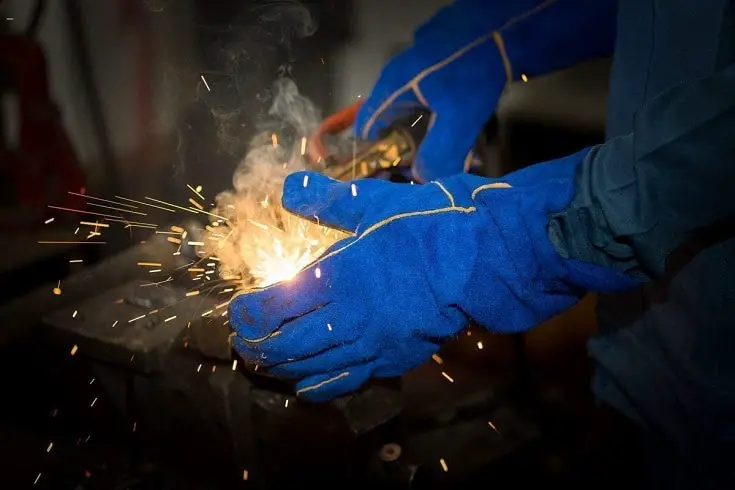Have you ever heard the expression “When safety comes first, you come last”? Well, welding is often a dangerous activity, and keeping yourself safe will keep you alive for a long time. In the same way, wearing gloves while welding protects both the wrist and the hands from hot metals.
Welding gloves not only protect welders from electrical shock, but they also increase grip and abrasion resistance during welding.
The heat resistance feature of welding gloves protects your hand if you pick up or rest on a hot piece of metal as these gloves can resist temperatures as high as 2000°F for brief periods of time and can withstand temperatures up to 600°F for extended hold durations. However, the heat resistance of welding gloves varies based on the material.
Many thicker gloves contain an extra liner to aid with this feature. Hot welded metal emits heat in the form of infrared radiation, which can potentially burn unprotected skin, therefore gloves are required.
Welding Glove Material
Welding glove materials might differ on the inside and outside. The outside is often concerned with protection and covering, whereas the interior is concerned with comfort and dexterity. But both the inside and outside should be heat resistant, regardless of material.
Exterior Materials for Welding Gloves
1.) Welding Gloves made of Leather
It is the most popular material for welding gloves, and each variety of leather has distinct qualities since it originates from different animals.
Here are some examples of leather and their distinctions:
-
-
- Cowhide– Abrasion-resistant and long-lasting.
- Deerskin– Extremely soft and sensitive, it gives all-day comfort.
- Pigskin– Long-lasting due to its porous structure.
- Goatskin– A tougher and more durable leather.
- Calfskin– Less durable than cowhide, but more flexible.
-
2.) Kevlar
This synthetic fabric is particularly resistant to heat. The finest feature of this substance is that it does not melt. Kevlar can endure temperatures as high as 800°F. It’s also super resistant to cuts and abrasion.
3.) Fiberglass
Carbon fibre can resist temperatures in excess of 2000°F for up to 2 minutes. These have been widely employed in aerospace, civil engineering, and even the military because of its great tensile strength and high temperature tolerance.
Interior Fabrics in Welding Gloves
The same material used on the outside of the welding gloves will most likely be found inside as well. If not, the interior will be made of a more pleasant and heat-resistant material, such as foam or wool.
Occasionally, the inside will have a mix of the following materials:
Foam– A lightweight material that creates a cushion effect by acting as an air barrier. Keep your hand comfortable.
Kevlar– As previously stated, this material is resistant to cuts and heat, as well as being versatile and strong.
Jersey– The most cost-effective alternative for heat protection.
Thinsulate- One of the most popular insulation materials.
Wool- It is the best natural insulating material. It dries rapidly as well.
Why is Hand Protection Necessary While Welding?
-
-
- Hand and finger injuries account for more than a quarter of all occupational accidents.
- Work-related burns account for 20-25% of all major burns that necessitate hospitalisation.
- 70% of employees who had hand injuries did not wear gloves at the time of the incident.
-
(Source- https://www.ncbi.nlm.nih.gov/pmc/articles/PMC3230153/)
In the world of welding, our hands, together with our eyes, are the most vital equipment.
Before we select the appropriate gloves, we must first ensure that we understand the various risks that may exist, so that we know what they should protect us against.
The finest welding gloves shield your hands from sharp metal edges, jagged surfaces, red hot metal, sparks, and other flying metal. Gloves can also shield your hands from the UV rays released by arc welding.
The risks to our hands in the welding industry are numerous. Let us see-
-
-
- If our hands become stuck or pressed between two things, they might be smashed or crushed.
- When we are exposed to sharp edges and other jagged surfaces, we can cut our hands.
- Red hot metal, sparks, and other hot flying metal may burn our hands.
-
Therefore, proper welding gloves protect against all the above mentioned hazards. Gloves also shield our hands from the intense light and UV rays released by the welding arc.
Considerations When Purchasing Welding Gloves
If you need to buy welding gloves, there are various factors to consider while selecting the correct pair. Consider the following:
Heat resistance:-
1.) Physical Safety- One reason why all welders must wear gloves on the job is that they will be working with and around a lot of powerful and heavy gear.
Cuts, abrasions, blunt force, and other injuries are prevalent in such industrial environments, thus welders’ gloves protect their hands from physical harm even when they’re not welding.
2.) Comfort- While you would believe that comfort should be compromised in favor of greater protective measures, the opposite is true.
Welding is a physically demanding task, and the gloves must protect the user not only from the welding process but also from the work environment’s lifestyle.
Welding gloves that are properly suited will absorb sweat to minimise steam burns and decrease stress, wear, and strain on your hands while you handle gear, material, and goods.
3.) Longevity- The final factor to consider when purchasing welding gloves is how long you want to use them. As with nearly anything, the more you spend, the higher the quality of the gloves and the longer they will endure.
If you are regularly exposed to heat or electricity, you might consider investing in a higher-quality pair. If you only need to protect your body from thermal harm a few times a year, consider purchasing hand pads instead of welding gloves.
Heat Resistant Gloves for Welders
This is the most important factor to be considered while choosing a proper welding glove. All welders need gloves with heat protection, but different types of welding produce different levels of heat, which means different gloves may be appropriate depending on the type of welding you’re doing.
For example:
Stick welding involves very high heat and lots of splattering. You need heavy-duty gloves with the highest level of heat protection if you’re stick welding, ideally, gloves that extend past the wrist and part way up the arm.
TIG welding, on the other hand, requires a higher level of dexterity and poses less of a risk for burns from heat and splattering. High-quality goatskin gloves are great for TIG welding. Just make sure they are comfortable and fit properly.
MIG welding exposes you to more heat, sparks, and splattering than TIG welding. You may feel most comfortable using the same heavy-duty gloves you’d use for stick welding, or you might choose slightly lighter weight heat resistant gloves that are easier to move your hands in.
Recommended Heat Resistant Gloves For You
1.) Revco GM1611 Top Grain Leather Gloves
The Revco Welding Gloves include strong, flexible cowhide palms and backs. These gloves are pleasant to use for extended periods of time since they include a complete cotton lining inside.
They also have Kevlar stitching on every seam for increased durability in the high-temperature, high-impact environment caused by welding procedures.
- Mig Welding Gloves
- Grain Cowhide Leather Palm
- Reinforcement Patches
- Kevlar Stitch
Prices pulled from the Amazon Product Advertising API on:
Product prices and availability are accurate as of the date/time indicated and are subject to change. Any price and availability information displayed on [relevant Amazon Site(s), as applicable] at the time of purchase will apply to the purchase of this product.
2.) RAPICCA Leather Welding Gloves
The Rapicca Welding Gloves include a complete leather outer shell. It employs thick, soft, and flexible shoulder split cowhide to make these gloves thick while remaining flexible. They have been heat, grease, and fire resistant treatment.
- REINFORCED DOUBLE LAYER KEVLAER PADDING ON FINGER,PALM,ELBOW
- EXTREME FOUR LAYER HEAT RESISTANT PROTECTION
- SUPERIOR SECURITY FOR FORERAMS
- EXTREME WEAR RESISTANT PROTECTION
Prices pulled from the Amazon Product Advertising API on:
Product prices and availability are accurate as of the date/time indicated and are subject to change. Any price and availability information displayed on [relevant Amazon Site(s), as applicable] at the time of purchase will apply to the purchase of this product.
3.) Lincoln Electric Traditional Welding Gloves
The Lincoln Electric Traditional Gloves are composed of split shoulder cowhide and offer complete leather covering.
They’re fully lined with cotton for all-day comfort in the rigorous professional welding environment. These Gloves are fully stitched with Kevlar and include leather reinforcement on every seam for increased impact resistance and heat protection.
- GREAT HEAT RESISTANCE
- INDUSTRIAL DURABILITY
- SUPERIOR COMFORT
- USED BY PROFESSIONALS
- Recommended for Stick welding (SMAW), Mig welding (GMAW), Flux-Core welding (FCA
Prices pulled from the Amazon Product Advertising API on:
Product prices and availability are accurate as of the date/time indicated and are subject to change. Any price and availability information displayed on [relevant Amazon Site(s), as applicable] at the time of purchase will apply to the purchase of this product.
4.) Miller Electric Welding Gloves
Because the lining of the Miller gloves is made of fleece over foam, they are intended for professional welders. This provides a pleasant sensation and a secure fit.
They will avoid bruising on your hands because they are thick and strengthened. It is also extremely heat resistant. They include Kevlar stitching for sturdy seams that are resistant to the hostile environment.
- Pig Split Leather
- Multi-Layered Insulation
- Pre-Curved Fingers
- Keystone Thumb Design
- Flame Resistant Kevl
Prices pulled from the Amazon Product Advertising API on:
Product prices and availability are accurate as of the date/time indicated and are subject to change. Any price and availability information displayed on [relevant Amazon Site(s), as applicable] at the time of purchase will apply to the purchase of this product.
Conclusion
Apart from all the various dangers of welding, heat is the most common and dangerous. Therefore, you need to ensure that you are safe and your hands are protected.
There are times when you need to pick up hot metals with your hands which might prove to be extremely dangerous, but with the right pair of gloves, you are sorted.
That is why a dependable set of welding gloves protect your hands and arms from dangerous burns while working.












